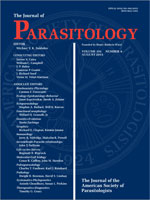The endogenous life cycle of Eimeria marmosopos was studied in experimentally infected young opossums, Didelphis marsupialis. All the endogenous stages were located in the epithelial cells of villi in the small intestine. Giemsa-stained mucosal scrapings and histological sections were studied for the diagnosis of all the life cycle stages. Eimeria marmosopos has 3 generations of meronts (M) that differ by size, shape, and number of merozoites (m), which also differ in their size, shape, and location of their nuclei within the cytoplasm of the meronts. The 3 meront types, M1–M3, respectively, had 8–15 (m1), 4–9 (m2), and 22–30 (m3) merozoites. Macrogametocytes and microgametocytes, as well as macrogametes and microgametes, completed the sexual cycle, finishing with the formation of unsporulated oocysts. This parasite's endogenous development produced severe intestinal lesions in experimentally infected opossums. There are 56 Eimeria species known from all marsupials worldwide, but this is the first complete life cycle in which both the asexual and sexual stages have been documented.
How to translate text using browser tools
1 August 2015
Endogenous Life Cycle of Eimeria marmosopos (Apicomplexa: Eimeriidae) from the Opossum, Didelphis marsupialis (Didelphimorphia: Didelphidae) in Costa Rica
Misael Chinchilla,
Idalia Valerio,
Donald Duszynski
ACCESS THE FULL ARTICLE

Journal of Parasitology
Vol. 101 • No. 4
August 2015
Vol. 101 • No. 4
August 2015




